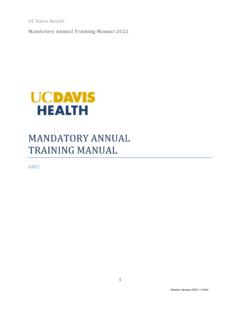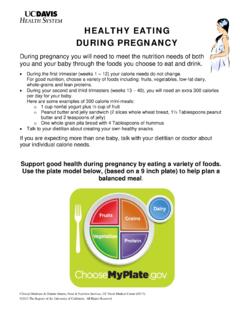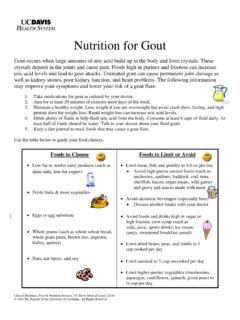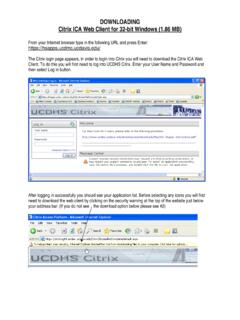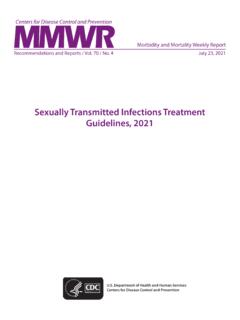Transcription of VANCOMYCIN-RESISTANT ENTEROCOCCI (VRE) URINARY …
1 VANCOMYCIN-RESISTANT ENTEROCOCCI (VRE) URINARY TRACT INFECTIONS (UTI) treatment recommendations AND ALGORITHM VRE UTIs are complicated UTIs Complicated UTIs represent a heterogeneous group of patients and clinical conditions but generally refer to infection of the URINARY tract with functional or structural abnormalities, including long-term indwelling catheters, recent URINARY instrumentation, neurogenic bladder, and renal calculi. Other complicating factors may include nosocomial acquisition and immunodeficiency ( renal insufficiency and/or transplant, neutropenia, human immunodeficiency virus HIV, and extremes in age). Lower tract vs.
2 Upper tract VRE UTIs It is important to distinguish lower tract ( cystitis) from upper tract ( pyelonephritis) VRE UTIs as part of the initial patient workup. Symptoms of a lower tract UTI or cystitis may include URINARY frequency, urgency and dysuria Symptoms of an upper tract UTI or pyelonephritis may include fever, chills, flank pain, costovertebral angle tenderness, and nausea/vomiting. Catheter-associated UTIs (CA-UTI) per IDSA guidelines (CID 2010;50:625-663) Signs and symptoms of CA-UTI include: new onset or worsening of fever, rigors, altered mental status, malaise, or lethargy without another cause, flank pain, CVA tenderness, acute hematuria, pelvic discomfort.
3 Pyuria is not diagnostic of CA-UTI and should not be interpreted as an indication for treatment . The absence of pyuria in a symptomatic patient suggests a diagnosis other than CA-UTI. Catheters that have been in place for >2 weeks at the onset of CA-UTI should be removed or replaced to hasten resolution and prevent recurrence. Urine cultures should be obtained after catheter replacement or removal and to help guide treatment . Asymptomatic bacteriuria (ASB) per IDSA guidelines (CID 2005;40(5):643-654) Defined as a urine culture with significant colony counts of bacteria in absence of symptoms Significant colony counts: o Women: 2 consecutive clean-catch urine samples with the same bacterial species isolated and quantitative counts > 105 CFU/mL of urine o Men.
4 1 clean-catch urine sample with one bacterial species isolated and quantitative count > 105 CFU/mL of urine Catheter associated bacteriuria defined as urine samples obtained via indwelling urethral catheter, indwelling suprapubic catheter or intermittent catheter with one or more bacterial species isolated in quantitative counts > 105 CFU/mL of urine in an asymptomatic patient. Should not be treated with antibiotics except in pregnant women, patients undergoing urologic manipulation, patients with URINARY hardware ( nephrostomy tubes or URINARY stents) and immunocompromised patients.
5 treatment ALGORITHM Treat VRE cystitis with at least seven days of antimicrobial therapy. Treat bacteremic VRE UTIs and pyelonephritis with 10 - 14 days of antimicrobial therapy for most cases. CA-UTI due to VRE may be treated with 3 days of therapy in women <65 years old without upper tract symptoms after URINARY catheter removal. Avoid ampicillin and use alternative agents if history of penicillin-class allergy or type-1 hypersensitivity reaction to cephalosporins ( immediate hypersensitivity reactions described as anaphylaxis, angioedema and/or swelling). Fosfomycin 3 grams given orally every other day for three doses has been used for VRE cystitis.
6 In select cases, a single 3 gram dose of fosfomycin therapy may be considered. Remove or replace indwelling URINARY catheters, ureteric stents, or nephrostomy tubes whenever possible. Review of antimicrobial agents with activity against VRE Drug Dosing* Cmax (plasma: mcg/ml) t 1/2 (hr) T 1/2 ESRD Protein binding (%) F (%) Renal Excr (%) Special Monitoring, precautions Comments Daptomycin (ID approval) 4mg/kg IV daily 8 27 92 NA 60 CPK lab (baseline & weekly) Dose adjustments required for CrCl < 30ml/min More rapid response compared to ampicllin and vancomycin against E. faecalis animal models of pyelonephritis and UTI13 In case series of 10 patients with VRE UTIs, daptomycin was clinically Great activity against VRE catheter colonization and biofilm formation15; Use for complicated UTIs Linezolid (ID approval) 600mg IV/PO q12h NA 31 100 30 CBC Median cumulative renal excretion of linezolid (44%) equal to that of ciprofloxacin (43%).
7 16 Weak activity against VRE biofilm compared to daptomycin and doxycycline;15 Use for complicated UTI Vancomycin See Dosing Guidelines 20-50 5-11 > 100 50 NA 85 Scr +/- vanco trough Obsolete for VRE isolates, included for comparison Nitrofurantoin dihydrate 100mg PO q6h 50-250 (urine) 1 NA 90 90 50 Give with food; Avoid if CrCl < 50 ml/min given ineffective and risk for peripheral neuropathy Great activity against enterococcus,8-10 should be first line for simple VRE UTIs given the isolate is susceptible; Only use for uncomplicated cystitis Tetracycline 500mg PO q6h 4-5 (po), 8 (iv) 6-12 Up to 100 20-60 60-80 60 Food and divalent cations decrease absorption by 50% Appears to have better activity against VRE than VSE at UCDMC (see susceptibility review); Only use for uncomplicated cystitis Doxycycline 100mg IV/PO q12h (po) 5-10 (iv) 15-22 18-26 80-90 90 30-40 Food and divalent cations decrease absorption by 20% Better activity against Enterococcus spp.
8 Compared to tetracycline (at one institution 40% and 90% of VRE urine isolates were sensitive to tetracycline and doxycycline, respectively); Good activity against VRE biofilm 15 Levofloxacin (ID approval) 250-500mg IV/PO daily (po) (iv) 6-8 76 +/- 42 24-38 90+ 61-87 Divalent cations decrease absorption by 20-50%, potential QT prolongation; Dose adjustments required for renal dysfunction Fluoroquinolones have in-vitro activity against enterococcus from urine sources, but cure rates have been less than remarkable. 3 Fosfomycin (ID approval) 50mg/kg (max 3 gm) PO x 1 32-128 +/- up to 50 < 3 34-58 40-60 Signs and symptoms of hypersensitivity; The t 1/2 is prolonged with renal dysfunction, but specific dosing recommendations are not available High URINARY levels of active drug persist for 48 hours or longer following oral doses; Urine concentrations of 2000 to 3000 mcg/ml are achieved during the first four hours and levels > 100 mcg/ml are maintained after 48 hours; Multiple doses of 3 grams do not offer any advantage compared to a single 3 gram dose of fosfomycin for simple UTIs.
9 The proportion of VRE isolates susceptible to fosfomycin was in a review of the use of fosfomycin for VRE UTIs18 Fosfomycin can limit the use of linezolid and daptomycin for uncomplicated VRE cystitis resistant to nitrofurantoin and tetracycline, thus reducing the chance of development of further resistance to these antimicrobial agents. Use for uncomplicated cystitis Ampicillin 1-2 grams IV q4-6h (500mg IV) 1 to 2 15-20 20 50 60-80 Dose adjust for renal dysfunction Ampicillin should be considered the drug of choice for VRE UTIs if the isolate is susceptible; Gentamicin 1 mg/kg IV q8h can be used with ampicillin for synergistic combination therapy in complicated UTIs if in- vitro susceptibility without high level gentamicin resistance.
10 Amoxicillin is good oral choice for uncomplicated cystitis. Approved by UCDH Pharmacy and Therapeutics Committee 4/2018. Key: Cmax=maximum concentration, mcg=micrograms, mg=milligrams, ml=milliliter, t1/2=half life, ESRD=end stage renal disease, excr=excretion, BL=baseline, Qwk=weekly, Q=every, CrCl=creatinine clearance, PO=oral, IV=intravenous, min=minute, hr/h=hour References: 1. Zirakzadeh A, Patel R. VANCOMYCIN-RESISTANT ENTEROCOCCI : Colonization, Infection, Detection and treatment . May Clin Proc. 2006; 81 (4): 529-536. 2. Torres-Viera C, Louise-Marie D. Approaches to VANCOMYCIN-RESISTANT ENTEROCOCCI . Curr Opin Infect Dis.
